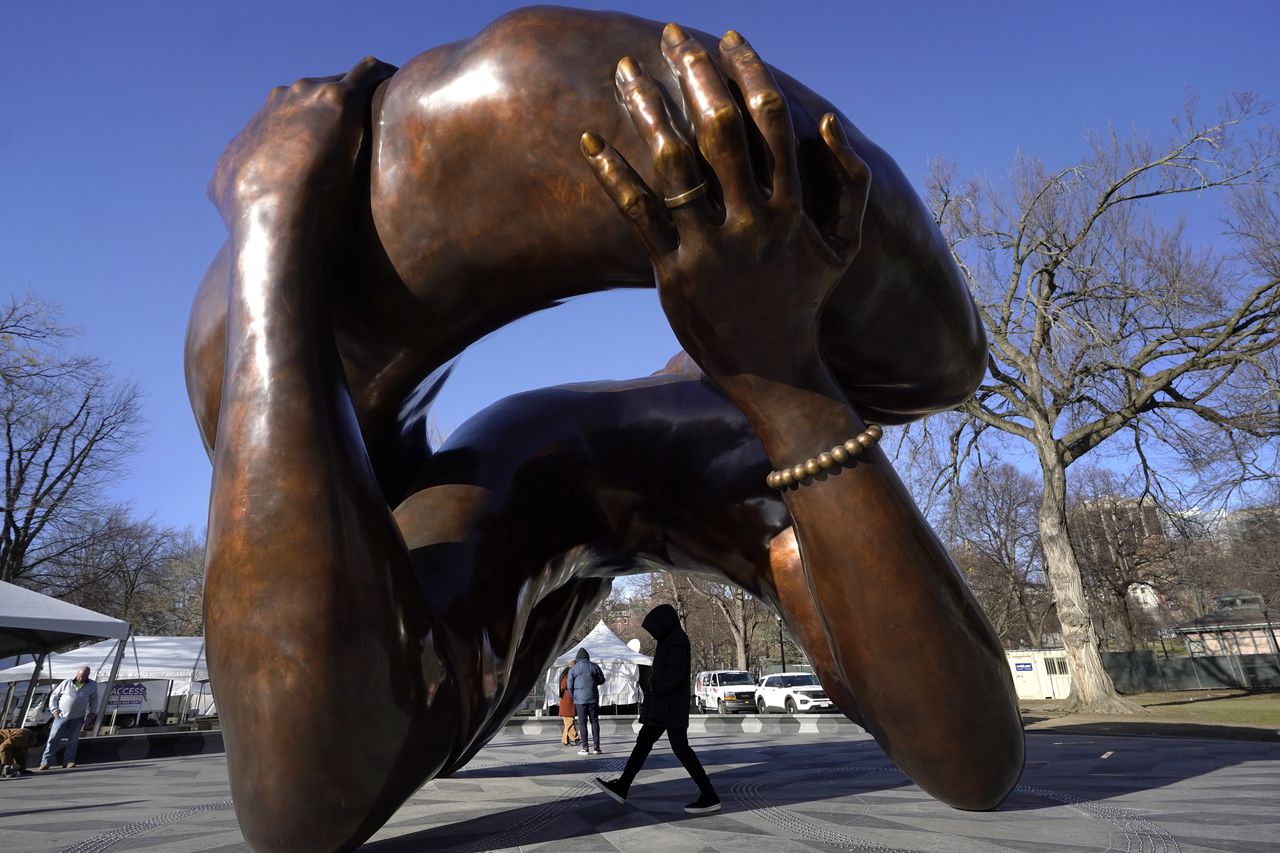Several notable figures of African American history have had ties to Massachusetts. From the early days of the abolitionist movement to the Civil Rights era and beyond, many African American scholars, activists and writers have had ties to the Bay State.
Phillis Wheatley, the first African American to publish a book of poetry in America, lived in Boston. Sojourner Truth, who delivered her famous “Ain’t I a Woman?” speech got her start in the abolition movement in Northampton. W.E.B. Du Bois, the first African American to obtain a Ph.D. from Harvard University, was born in Great Barrington.
As we celebrate Black History Month, MassLive is highlighting six notable and historically prominent African Americans with ties to Massachusetts.
Phillis Wheatley was the first African American woman and the third American woman to have a book of poems published in colonial America, according to the National Women’s History Museum.
Phillis Wheatley was born in Gambia in 1753. She was sold to the Wheatley family in Boston in 1761 after being abducted from her home by slave traders, according to the museum.
Under the tutelage of the Wheatley family, Phillis learned how to read and write in English, Greek and Latin by age 9, according to Poets.org.
Phillis Wheatley began writing poetry at 13. Her poem, “An Elegiac Poem, on the Death of the Celebrated Divine George Whitefield,” which was published in 1770, garnered her national attention, according to Poets.org.
In 1771, Phillis traveled to London with the Wheatleys, where her poetry was also well-received, according to Poets.org. While in the U.K., Phillis published a collection of poems, “Poems on Various Subjects, Religious and Moral,” which was the first book of poetry written by an African American. A shipment of the book came to Boston on the Dartmouth, the same ship revolting Bostonians threw thousands of pounds of tea from into the Boston Harbor on Dec. 16, 1773, according to the Bay State Banner. But, Wheatley’s work was unloaded the night before the famous Boston Tea Party, escaping a watery demise.
The book includes poems about race such as “On Being Brought from Africa to America,” which discusses Phillis’ experience of being stripped from her homeland and brought to America as an enslaved girl.
“Enslavers and abolitionists both read her work; the former to convince the enslaved population to convert, the latter as proof of the intellectual abilities of people of color,” according to the National Women’s History Museum.
Phillis returned to Boston in 1773, according to Poetry.org. She was freed shortly after the Wheatleys died – sometime between 1774 and 1778, according to Poets.org.
She later married, John Peters, a grocery store owner, in 1778 and had three children with him – all of whom died young, according to Poets.org. Phillis struggled to continue to support herself as a writer later in her life. Although she died around 1784, scholars continue to read her work.
Sojourner Truth was an abolitionist, speaker and feminist of the 19th century.
Truth was born as Isabella Bomfree, an enslaved person in New York in 1797, according to Britannica. After gaining her freedom, she left New York in 1843 and took the name Sojourner Truth. She traveled across the country, preaching about accepting God and the brotherhood of man.
Truth spent a significant portion of her life in Northampton, Massachusetts, where she became involved in the abolitionist movement. A statue honors her life in Florence at Pine and Park streets. She worked with fellow abolitionists William Lloyd Garrison, Frederick Douglass and Wendell Phillips to advocate for the freedom of enslaved people, according to historicnorthampton.com.
Truth’s relationship with fellow abolitionists helped her gain notoriety in the world of 19th-century reform, historicnorthampton.com reported.
Frederick Douglass was born into slavery in Maryland in 1818 and escaped to Massachusetts in 1838, where he became a leading abolitionist, according to the National Park Service.
In Massachusetts, Douglass became involved in the abolitionist movement, according to PBS.org. In 1841, after seeing William Lloyd Garrison speak at the Bristol Anti-Slavery Society’s annual meeting, he was inspired to write a speech, too.
Later, Douglass gave his speech at the Massachusetts Anti-Slavery Society’s annual convention in Nantucket, according to PBS.org.
Before leaving Nantucket, Douglass was asked to become a lecturer for the Anti-Slavery Society for three years, which helped launch his career as an abolitionist nationwide, PBS.org reported.
William Edward Burghardt Du Bois was born in Great Barrington, Massachusetts in 1868, according to The Du Bois National Historic Site Project.
Du Bois attended Fisk University in 1885, according to Harvard University. He later obtained a second bachelor’s degree from Harvard University, followed by a master’s degree and Ph.D., making him the first African American to receive a doctorate from the school.
“The honor, I assure you, was Harvard’s,” he said, according to Harvard University.
Known for his scholarship, Du Bois has written several works such as “The Suppression of the African Slave Trade,” and “The Philadelphia Negro,” according to The Du Bois National Historic Site Project.
But, Du Bois is known for his most famous work, “The Souls of Black Folk,” where he coins the term “double consciousness.” The phrase describes the competing mindsets African Americans have feeling both Black and both American in a predominately white society.
He was also the founder of the Niagara Movement, the National Association for the Advancement of Colored People and the Pan-African Congresses, The Du Bois National Historic Site Project reported.
Civil rights leader Malcolm X moved to Boston after his father was lynched by the Ku Klux Klan and his mother was institutionalized, according to Britannica.
While he was in the city, he fell into a life of petty crime and was ultimately sent to prison for burglary, Britannica reported. He later joined the Nation of Islam, a movement that combined the teachings of Islam with elements of Black nationalism.
After he left prison in 1952, Malcolm chose “X” as his last name as a way to signify his rejection of his slave name “Little,” Britannica reported.
Malcolm X became a vocal speaker and leader for the Nation of Islam after he met the organization’s leader, Elijah Muhammad, Britannica reported.
As a leader, Malcolm X expressed his frustrations regarding how African Americans were treated in white society. He also criticized the civil rights movement and called for Black Americans to defend themselves against violence, Britannica reported.
But, after taking a pilgrimage to Mecca – also known as the Hajj – Malcolm X adopted a more worldly understanding of Islam and abandoned the Nation of Islam in 1964, Britannica reported.
Although Dr. Martin Luther King Jr. was born in Atlanta, when he moved up to Boston, he considered the city his second home, according to Meet Boston, a non-profit visitors bureau for Greater Boston.
Boston was not only the place where King earned his Ph.D. in theology from Boston University, it was also the place where he met his wife, Coretta Scott King, Meet Boston reported.
King visited Boston and held several speeches in the city regarding unity, racial equality and perseverance in the 1960s, Meet Boston reported. The civil rights activist spoke at Ford Hall weeks before he went to jail in Birmingham, the website said.
Two years down the road, King visited Boston again to address the Massachusetts state Legislature before leading his march from Roxbury to Boston Common, Meet Boston reported.
While giving a speech on the Boston Common, King spoke of the “twin evils of housing and employment discrimination,” Meet Boston reported.
Today, a statue, “The Embrace,” dedicated to King and his wife Coretta, stands in the middle of Boston Common. The statue portrays King and his wife embracing each other after he won the Nobel Peace Prize.








